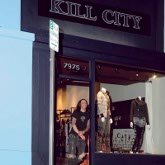Manufacturers Get Creative to Weather Economic Lean Times
While retailers toss up holiday sale signs and heavily promote their online storefronts in an effort to capture skittish shoppers, manufacturers are tackling their own set of challenges. Buyers are coming to market with tighter budgets, a conservative agenda and an eye toward buying as close to season as possible. Prices for everything from imported fabrics to shipping, labor and energy are up. Retailers, struggling to keep up with bills, are being declined credit by factors, narrowing the field of potential accounts for brands.
“To say that it is a tough time for manufacturers in California is an understatement,” said Jon Levine, founder of the Beverly Hills–based Apparel Advisors consultancy company and a longtime veteran of the apparel industry. “I’ve been in the apparel industry for a few cycles, but I’ve never seen anything as deep as this.”
Anecdotally, the evidence that brands are feeling the pressure is mounting. Unconfirmed reports say many once-darling California brands are struggling, the latest being Mike & Chris, which is said to be undergoing a “restructuring.” Quietly, floundering brands are looking for investors. Reports of layoffs are trickling in. Economic indicators continue their slide. In October, with the loss of 26,400 jobs, California’s jobless rate jumped to 8.2 percent—the worst in 14 years. Only two states have higher unemployment rates, and economists fear California’s situation will get worse before it gets better.
While retailers are laying off workers in greater numbers, California’s apparel manufacturing community has also suffered. Since last October, manufacturers and textile mills have shed 2,300 jobs. In comparison, apparel retailers in the state have shed 3,800 jobs since last October, and department stores have lost 12,900 jobs in that same time period, according to Jack Kyser of the Los Angeles County Economic Development Corp. “Manufacturing is still losing jobs but not at the same pace as retail,” Kyser said. “We are in a recession that will last until about the middle of 2009. The big job losses in retail will be felt on the manufacturing side. There is a lot of excess capacity, and it is starting to show up in these numbers.”
Shifting Strategies
To stay afloat, brands are opting for a variety of strategies.
Drew Bernstein, founder of the Kill City and Lip Service brands, has culled his offerings by approximately 40 percent across the board, cutting out styles that aren’t in the running for “instant classics” and being loyal to styles that have performed well at retail. “Less styles mean less inventory. It’s a more calculated design approach. We’re focusing on our core strengths,” Bernstein said. Other changes have come in the form of a slimmed-down staff of approximately 50 people and closer monitoring of costs such as overtime. Production has also seen a shift. With smaller production runs, Bernstein has brought some production back stateside, making for faster turnaround and saving on shipping.
The tough economy has also encouraged Bernstein to be more accommodating to retailers’ design directions. “Buyers are designers in disguise,” Bernstein said. “We’re all on a commercial endeavor. We’ll change styles if [buyers] have a good idea. If it’s a bad idea but a big enough order, I’ll say, ’Sure, why not.’” The biggest gamble Bernstein has taken, however, is the new 800-square-foot Kill City store that opened on Melrose Avenue on Nov. 15. Packed with Kill City’s edgy, rock ’n’ roll–tinged fashions for men and women, the store is meant to help establish the brand—but it has a secondary purpose. Among the current season’s goods are past-season items pulled from Kill City’s warehouse, making it an ideal way to siphon off excess inventory. “We’re lucky. We have orders. We have work. We see the economy is taking a downturn, but we’re still able to charge ahead and open a store,” Bernstein said. And he sees a silver lining in the clouds. “Consumers are always looking for a deal, and stores have to sell something. We offer good stuff at reasonable prices, so we’re looking to fill that gap.”
Designers Emily Brandle and Michelle Chaplin of the contemporary brand Smoke & Mirrors are taking a different approach to ride out the recession. Launched in 2006 with plenty of party dresses and loads of special-occasion details, the brand took a more casual and price-conscious turn for Spring 2009. “Where before we were using lots of silks and wool and imported European fabrics, now we’re using cottons and linens and silk blends,” Brandle said.
The result is a collection of pretty daywear pieces at prices that fall 40 percent below those of previous collections. “The price point is better, and retailers are able to offer more Smoke & Mirrors styles. It has also broadened our appeal, and stores that couldn’t afford us but liked the brand are now an option,” Brandle said.
The duo also took on more duties to save on expenses. “Basically, anything that Michelle and I can do ourselves we’re bringing in-house. Now we are cutting our own samples instead of sending them out, for example. We’re putting the hustle into it, cutting out as many middlemen and getting as close to the source as we can,” Brandle said. “We’re taking the hit so we can stay afloat.”
Levine, the former chief operating officer of James Perse and former president of Splendid and Ella Moss, specializes in helping brands with everything from organizational restructuring to sales and distribution planning, accounting, design, and merchandising. Clients include Orthodox, Whitehorse Couture, Trixxi Clothing and Luna Luna Copenhagen.
This year, Levine launched Duarte No. Q65 with designer Henry Duarte. The contemporary line represents the business model Levine believes in for brands in the current economic climate. For Duarte No. Q65, Levine has outsourced technical functions and production overseas and has finished goods sent directly to a pick-and-pack facility. “The model is seamless. Everything is tied to a sale and there is no floating overhead,” he explained. “We have a very small design office, and one partner is an overseas full-package manufacturer. We all wear many hats.”
According to Levine, brands need to streamline their operations from the bottom up to lessen their overhead costs. Cut to order, outsource as much as possible and run as lean a staff as possible, he recommends. “Work out a full-package program if you can. If you have a big warehouse, try to sublet it and work with a pick-and-pack company,” Levine advised. “The days of big sample rooms and big design and development budgets and unlimited shows and travel are over. It is time to come back to reality.”

























